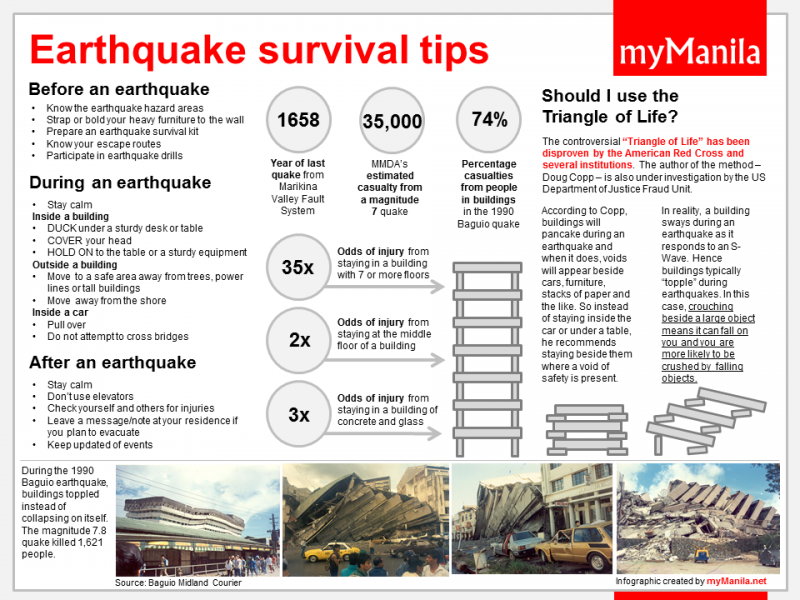Earthquake survival tips
Posted on Wednesday, 16 October 2013 2:16 pmLast modified on Tuesday, 17 December 2019 7:26 pm
As of 1:43pm this afternoon, the death toll in Bohol and Cebu has reached 110. If you wish to donate to the victims, the Philippine National Red Cross is accepting donations.
In part of the news, we have been receiving posts, questions and other inquiries on how to survive an earthquake specially in Manila where the Marikina Valley Fault System has not moved since 1658. A 2009 study reported that the MMDA predicts a 35,000 casualty rate when a magnitude 7 hits Manila. The Baguio quake was a magnitude 7.7, yesterday's Bohol quake was a 7.2.
The official Philippine protocol for earthquake safety is still with Philvolcs here. We urge you to do the steps outlined to ensure safety.
Noting that, please be also aware that the so called "Triangle of Life" method by Doug Copp has been disproved many times by different experts and international bodies around the world. We urge you to please STOP sharing that meme/post/facebook status.
Now to the facts. If we look at cases and controls used to measure statistics in the Baguio 1990 quake, we are faced with some grim numbers. 74% of casualties were found in buildings during the quake. The most common injuries were contusions (35%), fractures (14%), and lacerations (12%). The most common causes of which were being hit by falling objects (37%), being crushed or pinned by heavy objects (29%), and falling (7%).
Building height and material were factors affecting survival - persons in buildings that were 7 or more floors high were 35 times as likely to be injured. Persons in the middle sections or floors of those buildings were 2 times likely to be injured as those on upper or lower floors. Persons staying in buildings of mixed material (glass and cement) were 3 times as likely to be injured than those in wooden structures. These are of course statistics from a previous earthquake. The structures, population and topography in Baguio are different than those in Manila.
In part of the news, we have been receiving posts, questions and other inquiries on how to survive an earthquake specially in Manila where the Marikina Valley Fault System has not moved since 1658. A 2009 study reported that the MMDA predicts a 35,000 casualty rate when a magnitude 7 hits Manila. The Baguio quake was a magnitude 7.7, yesterday's Bohol quake was a 7.2.
The official Philippine protocol for earthquake safety is still with Philvolcs here. We urge you to do the steps outlined to ensure safety.
Noting that, please be also aware that the so called "Triangle of Life" method by Doug Copp has been disproved many times by different experts and international bodies around the world. We urge you to please STOP sharing that meme/post/facebook status.
Now to the facts. If we look at cases and controls used to measure statistics in the Baguio 1990 quake, we are faced with some grim numbers. 74% of casualties were found in buildings during the quake. The most common injuries were contusions (35%), fractures (14%), and lacerations (12%). The most common causes of which were being hit by falling objects (37%), being crushed or pinned by heavy objects (29%), and falling (7%).
Building height and material were factors affecting survival - persons in buildings that were 7 or more floors high were 35 times as likely to be injured. Persons in the middle sections or floors of those buildings were 2 times likely to be injured as those on upper or lower floors. Persons staying in buildings of mixed material (glass and cement) were 3 times as likely to be injured than those in wooden structures. These are of course statistics from a previous earthquake. The structures, population and topography in Baguio are different than those in Manila.
Archived in
Tagged with
Data Privacy Notice
We use cookies to ensure you get the best experience on our website. By continuing, you are agreeing to our use of cookies.





